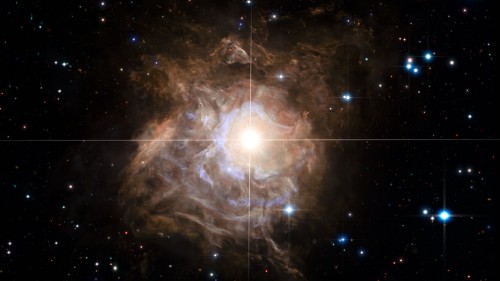
A star glowing in the night. (Courtesy: ESA/Hubble)
By Hamish Johnston
Things are winding down for the holidays at Physics World and this afternoon the team will be enjoying our Christmas lunch at a local brewpub. Hopefully they will have a festive ale or two on tap! To brighten up this festive blog, we have chosen this stunning image of the variable star RS Puppis as our Christmas picture. It was taken by the Hubble Space Telescope and shows starlight reverberating through the foggy environment around the star.
Wherever you may be over the holiday season, there is plenty on physicsworld.com to keep you amused. A highlight of December for me is choosing the Physics World Breakthrough of the Year and its nine runners-up. The process involves a round of voting by six editors and reporters; a spreadsheet analysis of the results; and then a good deal of raucous debate to resolve the inevitable ties that crop up in the scores.
This year’s winner was the IceCube collaboration for being the first to detect high-energy cosmic neutrinos. I did a live Google Hangout with two physicists working on the experiment, one of whom was at the South Pole where the IceCube detector is located. You can find out much more about IceCube and the rest of our top 10 breakthroughs for 2013 in our article “Cosmic neutrinos named Physics World 2013 Breakthrough of the Year“.
I don’t know a physicist who wouldn’t appreciate a good book for Christmas and there’s still time for a bit of last minute shopping. If you would like a recommendation, check out “Biophysics ‘rollercoaster ride’ wins Physics World‘s 2013 Book of the Year“. And in our Book of the Year 2013 podcast, three Physics World critics make the case for their favourite books of the year.
Elsewhere on the website, James Dacey has been busy in the screening room compiling his “Multimedia highlights of 2013“, which cover a range of topics from quantum computing to the lives of physicists working at a synchrotron facility. Michael Banks has gathered together the “Best of the blog 2013“, which includes a compromising photo of the Nobel laureate and former US energy secretary Steven Chu. The best physics-related images of 2013 have been chosen by Tushna Commissariat and include a shape-shifting metal and a gravitational lens at the edge of the universe:”Our favourite pictures of 2013“.
Matin Durrani has indulged in a bit of year-end crystallography and gazed into his crystal ball to make a few predictions of what “The world of physics in 2014” will bring. Last year he said that Peter Higgs “is surely a shoo-in” for the 2013 Nobel prize and he also tipped François Englert as a co-winner. Stay tuned to physicsworld.com to see how many of his predictions come true next year.
Finally, why not grab a mince pie and spend a few minutes testing your knowledge of this year’s physics events as reported in Physics World by taking our online quiz. I probably shouldn’t admit it, but I scored just 20/25. I’m sure you will do much better!
Guidelines
Show/hide formatting guidelines
this text was deletedwhere people live in harmony with nature and animals</q>
Some text